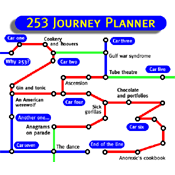work 1
253, by Geoff RYMAN (United Kingdom), 1996
MASS HYPERTEXTUAL TRANSIT
 Since its foundation in 1960, the work of the Oulipo - Ouvroir de Littérature Potentielle - has provoked criticisms that one can be summarized in two steps. First, strictures being, by definition, restricting (please ignore the tautology), such work is deemed castrating, a limitation imposed on authorial prerogative, a diminishment of the author's imagination. Second, more contemptuously, its use is deemed juvenile, testifying to the inconsequentiality of those who employ its techniques. On this last point, one may imagine the quaintest fiction, in which Racine is seen counting the feet of the verses in his most serious tragedies, methodically checking for alternating masculine and feminine forms in his rhyme. Beyond the already complex exigencies of language, one could list countless literary works that could not work without them. As to their reductive effect on authorial imagination, it only holds for those who believe that spilling one's guts onto the page produces true and enduring literature. Restrictions help form distance: a text is language and not experience.
Since its foundation in 1960, the work of the Oulipo - Ouvroir de Littérature Potentielle - has provoked criticisms that one can be summarized in two steps. First, strictures being, by definition, restricting (please ignore the tautology), such work is deemed castrating, a limitation imposed on authorial prerogative, a diminishment of the author's imagination. Second, more contemptuously, its use is deemed juvenile, testifying to the inconsequentiality of those who employ its techniques. On this last point, one may imagine the quaintest fiction, in which Racine is seen counting the feet of the verses in his most serious tragedies, methodically checking for alternating masculine and feminine forms in his rhyme. Beyond the already complex exigencies of language, one could list countless literary works that could not work without them. As to their reductive effect on authorial imagination, it only holds for those who believe that spilling one's guts onto the page produces true and enduring literature. Restrictions help form distance: a text is language and not experience.
Some might think that, on the face of it, the explosion ushered by hypertext on the Net might not suit the rigid markers of constraints. That is to miss the idea entirely. Published in book form in 1998, after a first version began appearing on the Web in 1996, 253, a novel by Canadian author Geoff Ryman1, shows the potential for such an alliance.
Subtitled "the Journey of 253 Lifetimes," the novel tells of a trip on the subway. The action, such as it is, takes place on the London Tube and rests on the following premise: The Tube, when fully occupied, may contain 252 people, to which we add the driver, for a total of 253. Each of the seven chapters deals with one of the various cars that make up the train. A drawing first presents the car, with the name of each of the people within, some information on each of them (from one to three words) and the seat they occupy. Then, each page gives a portrait - in no more and no less than 253 words - of a traveller, in three parts: "Outward appearance," "Inside information," "What she [or he] is doing or thinking." Footnotes sometimes provide particular information. The story takes place on January 11th, 1995, between 8:35 and 8:42, between the stations Embarkment and Elephant & Castle, and ends with an accident in a tunnel, told in a few pages. Between chapters, the novel is also strewn with fake advertising about 253. Recalling the constant solicitation one experiences daily on the subway, these inserts are intentionally (?) vulgar in their insistence on selling the reader the product he or she is currently reading.
While each page hypothetically deals with a single character, in reality it concerns a lot more, as some travellers are thinking of others situated in the same car and may be eyeing them with various degrees of interest.
The nearly telegraphic manner in which the author presents the characters, using the novel to sketch a gregarious society rather than give space to reflections on various psychological subjectivities, is somewhat suggestive of Manhattan Transfer by Dos Passos. One is tempted to imagine a hypertext adaptation of the novel.
With 253, the transition from pharmacopoeia to virtual universe is done naturally enough. One could even say that the novel seems like a metatextual model of hypertextual reading. Indeed, the ramification of the London Tube suggests a network. Hyperlinks are numerous between the 253 stories, allowing one to go from one character to another, sometimes, using a place-name, from one event to another.
Paradoxically, it's the very plasticity of the paper edition that makes the hypertext version a little disappointing. Indeed, the book itself can be read in non-linear fashion; it's very easy to broach it without ever reading pages in order. One can jump from one character to another, from one car to another, without jeopardizing reading continuity. The systemic effect of the work, its basic circularity, is immediately obvious by flipping through the pages. In this sense, the hypertext version simply "accelerates" the phenomenon, making it more - too? - explicit. One always hopes to read true adaptations, as marked (or almost) as the passage from book to film. While the result is here pleasant and (playfully) interesting, it remains rather predictable. At least for one who's already read the book. It remains to be seen if a comparative reading is necessary at all. The question remains open.

Notes
1 : Geoff Ryman, 253, New York, St. Martin's Press,
1998, 364 p. 
Jean-François Chassay
(Translated from French by Ron Ross)

 top top
 back back
|
